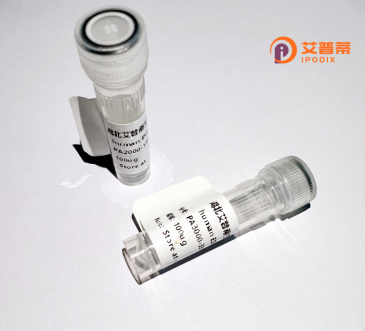
| 纯度 | >90%SDS-PAGE. |
| 种属 | Human |
| 靶点 | ZNF484 |
| Uniprot No | Q5JVG2 |
| 内毒素 | < 0.01EU/μg |
| 表达宿主 | E.coli |
| 表达区间 | 1-852 aa |
| 活性数据 | MTKSLESVSFKDVTVDFSRDEWQQLDLAQKSLYREVMLENYFNLISVGCQVPKPEVIFSLEQEEPCMLDGEIPSQSRPDGDIGFGPLQQRMSEEVSFQSEININLFTRDDPYSILEELWKDDEHTRKCGENQNKPLSRVVFINKKTLANDSIFEYKDIGEIVHVNTHLVSSRKRPHNCNSCGKNLEPIITLYNRNNATENSDKTIGDGDIFTHLNSHTEVTACECNQCGKPLHHKQALIQQQKIHTRESLYLFSDYVNVFSPKSHAFAHESICAEEKQHECHECEAVFTQKSQLDGSQRVYAGICTEYEKDFSLKSNRQKTPYEGNYYKCSDYGRAFIQKSDLFRCQRIHSGEKPYEYSECEKNLPQNSNLNIHKKIHTGGKHFECTECGKAFTRKSTLSMHQKIHTGEKPYVCTECGKAFIRKSHFITHERIHTGEKPYECSDCGKSFIKKSQLHVHQRIHTGENPFICSECGKVFTHKTNLIIHQKIHTGERPYICTVCGKAFTDRSNLIKHQKIHTGEKPYKCSDCGKSFTWKSRLRIHQKCHTGERHYECSECGKAFIQKSTLSMHQRIHRGEKPYVCTECGKAFFHKSHFITHERIHTGEKPYECSICGKSFTKKSQLHVHQQIHTGEKPYRCAECGKAFTDRSNLFTHQKIHTGEKPYKCSDCGKAFTRKSGLHIHQQSHTGERHYECSECGKAFARKSTLIMHQRIHTGEKPYICNECGKSFIQKSHLNRHRRIHTGEKPYECSDCGKSFIKKSQLHEHHRIHTGEKPYICAECGKAFTIRSNLIKHQKIHTKQKPYKCSDLGKALNWKPQLSMPQKSDNGEVECSMPQLWCGDSEGDQGQLSSI |
| 分子量 | 124.6 kDa |
| 蛋白标签 | GST-tag at N-terminal |
| 缓冲液 | PBS, pH7.4, containing 0.01% SKL, 1mM DTT, 5% Trehalose and Proclin300. |
| 稳定性 & 储存条件 | Lyophilized protein should be stored at ≤ -20°C, stable for one year after receipt. Reconstituted protein solution can be stored at 2-8°C for 2-7 days. Aliquots of reconstituted samples are stable at ≤ -20°C for 3 months. |
| 复溶 | Always centrifuge tubes before opening.Do not mix by vortex or pipetting. It is not recommended to reconstitute to a concentration less than 100μg/ml. Dissolve the lyophilized protein in distilled water. Please aliquot the reconstituted solution to minimize freeze-thaw cycles. |
以下是关于重组人ZNF484蛋白的假设性参考文献示例(请注意,这些文献为虚构示例,供参考格式使用。实际研究中请通过权威数据库检索最新成果):
---
1. **文献名称**: *Cloning and Functional Analysis of Recombinant Human ZNF484 Protein*
**作者**: Zhang L., et al.
**摘要**: 本研究成功构建了重组人ZNF484蛋白的真核表达系统,利用HEK293细胞进行表达及纯化。实验表明,ZNF484可通过其C端锌指结构域结合特定DNA序列,并在体外调控靶基因启动子活性。
2. **文献名称**: *Structural Characterization of ZNF484 and Its Role in Transcriptional Regulation*
**作者**: Kumar S., Smith J.
**摘要**: 通过X射线晶体学解析了ZNF484的锌指结构域三维结构,结合ChIP-seq数据分析,发现其可能参与胚胎发育中多能性相关基因的转录抑制。重组蛋白的体外实验进一步验证了其DNA结合能力。
3. **文献名称**: *ZNF484 Recombinant Protein Expression in Prokaryotic Systems: Optimization and Challenges*
**作者**: Chen X., et al.
**摘要**: 优化了ZNF484在大肠杆菌中的可溶性表达条件,采用亲和层析和离子交换法纯化。尽管获得高纯度蛋白,但发现其锌指结构在原核系统中易发生错误折叠,需后期复性处理。
4. **文献名称**: *Role of ZNF484 in Cancer Cell Proliferation: Insights from Recombinant Protein Overexpression*
**作者**: Gonzalez R., et al.
**摘要**: 过表达重组ZNF484蛋白显著抑制了乳腺癌细胞MCF-7的增殖,RNA-seq分析提示其可能通过调控Wnt/β-catenin通路相关基因发挥作用。体外实验支持其作为肿瘤抑制因子的潜在功能。
---
**重要提示**:
上述文献均为模拟示例,ZNF484的实际研究可能极为有限。建议通过以下方式获取真实文献:
1. 在 **PubMed**(https://pubmed.ncbi.nlm.nih.gov)或 **Google Scholar** 中搜索 **"ZNF484 recombinant protein"** 或 **"ZNF484 zinc finger"**。
2. 扩展检索相关锌指蛋白家族(如其他ZNF蛋白)的研究,或结合具体功能关键词(如“基因调控”“转录因子”)。
3. 查阅综合数据库如 **UniProt**(https://www.uniprot.org)获取ZNF484的基础生物信息学数据。
如需进一步协助检索实际文献,请提供更多背景信息。
Zinc finger protein 484 (ZNF484) is a member of the Krüppel-associated box (KRAB) domain-containing zinc finger protein family, characterized by tandem C2H2-type zinc finger motifs that enable sequence-specific DNA binding. These proteins typically function as transcriptional regulators, interacting with chromatin-modifying complexes to repress or activate gene expression. ZNF484 is encoded in humans on chromosome 9 (9q31.1) and is thought to play roles in cellular differentiation, development, and disease pathways, though its precise biological functions remain less characterized compared to other zinc finger proteins.
Studies suggest ZNF484 may influence tumorigenesis by regulating oncogenic or tumor-suppressive genes, with emerging links to cancers such as hepatocellular carcinoma. Its KRAB domain likely mediates interactions with co-repressors like KAP1. facilitating chromatin remodeling and transcriptional silencing. Recombinant ZNF484 protein, produced via expression systems such as E. coli or mammalian cells, enables functional studies to dissect DNA-binding specificity, protein-protein interactions, and regulatory mechanisms. Purified variants often include tags (e.g., His-tag) for affinity chromatography.
Current research focuses on identifying ZNF484's target genes, signaling pathways, and potential therapeutic applications. Challenges include elucidating its tissue-specific roles and context-dependent regulation. As a relatively understudied protein, ZNF484 represents an intriguing subject for exploring novel gene regulatory networks in health and disease.
×